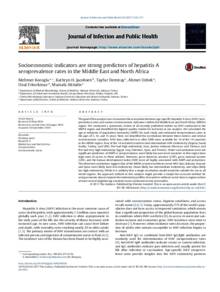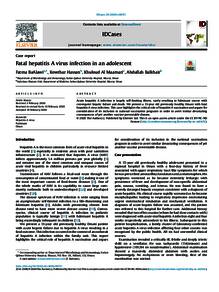Document
Socioeconomic indicators are strong predictors of hepatitis a seroprevalence rates in the Middle East and North Africa.
Identifier
DOI: 10.1016/j.jiph.2016.09.020
Source
Journal of Infection and Public Health. v. 10, 5, p. 513-517
Contributors
Jacobsen, Kathryn H., Author
Demiray, Tayfur., Author
Ozbek, Ahmet., Author
Erkorkmaz, Unal., Author
Altindis, Mustafa., Author
Country
Netherlands.
Publisher
Elsevier Ltd.
Gregorian
2017-09-01
Language
English
English abstract
The goal of this analysis was to examine the association between age-specific hepatitis A virus (HAV) seroprevalence rates and various socioeconomic indicators within the Middle East and North Africa (MENA) region. We conducted a systematic review of all recently published studies on HAV conducted in the MENA region and identified the highest quality studies for inclusion in our analysis. We calculated the age at midpoint of population immunity (AMPI) for each study and estimated seroprevalence rates at the ages of 5, 10, and 15 years. Next, we identified the correlations between these metrics and several socioeconomic variables. HAV data collected in or after 2000 were available for 14 of the 19 countries in the MENA region. Four of the 14 included countries had intermediate HAV endemicity (Algeria, Saudi Arabia, Turkey, and UAE), five had high endemicity (Iran, Jordan, Lebanon, Morocco, and Tunisia), and five had very high endemicity (Egypt, Iraq, Palestine, Syria, and Yemen). Water and sanitation were not significant predictors of AMPI or seroprevalence, most likely because most countries in this region have high rates of access to these utilities. However, gross domestic product (GDP), gross national income (GNI), and the human development index (HDI) were all highly associated with AMPI and prevalence. The observed correlations suggest that of the MENA countries without recent HAV data, Bahrain, Kuwait, and Qatar most likely have low endemicity, Oman likely has intermediate endemicity, and Libya likely has high endemicity. While it is unlikely that a single correlation model would be suitable for use in all world regions, the approach utilized in this analysis might provide a simple but accurate method for using economic data to impute the endemicity profiles of countries without recent data in regions where at least several neighboring countries have conducted recent serostudies.
ISSN
1876-0341
Resource URL
Category
Journal articles


